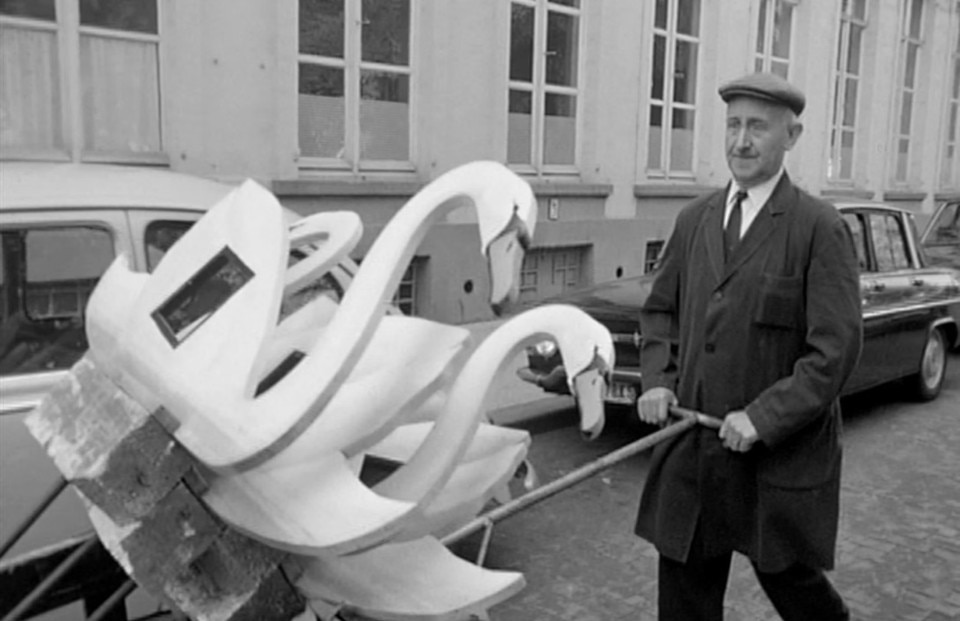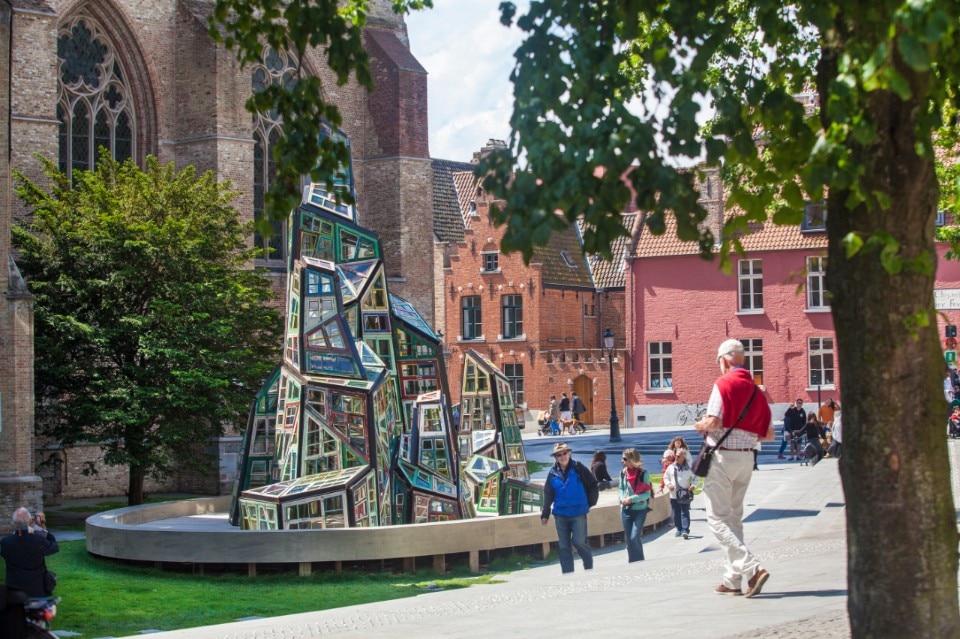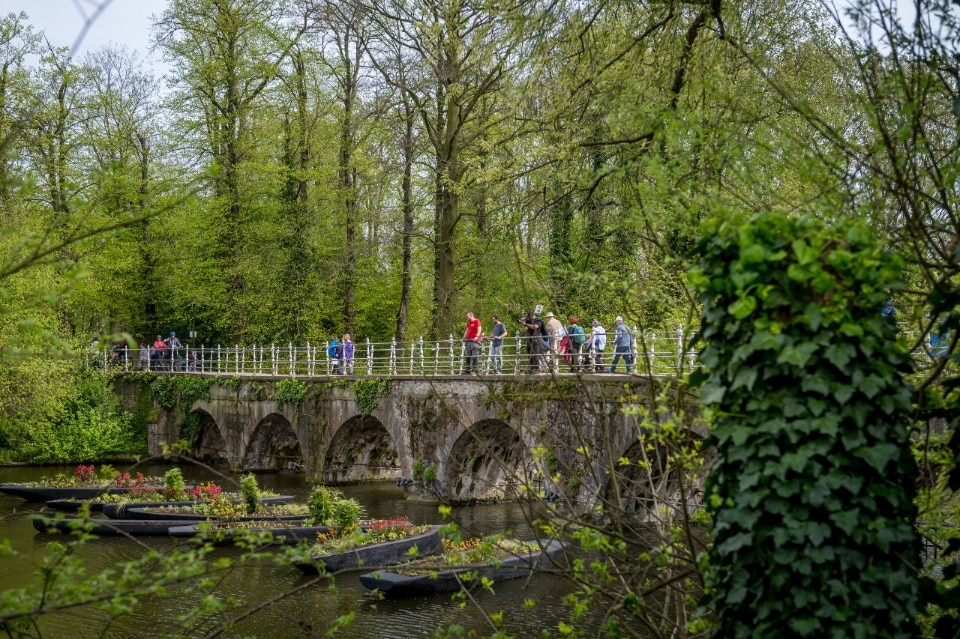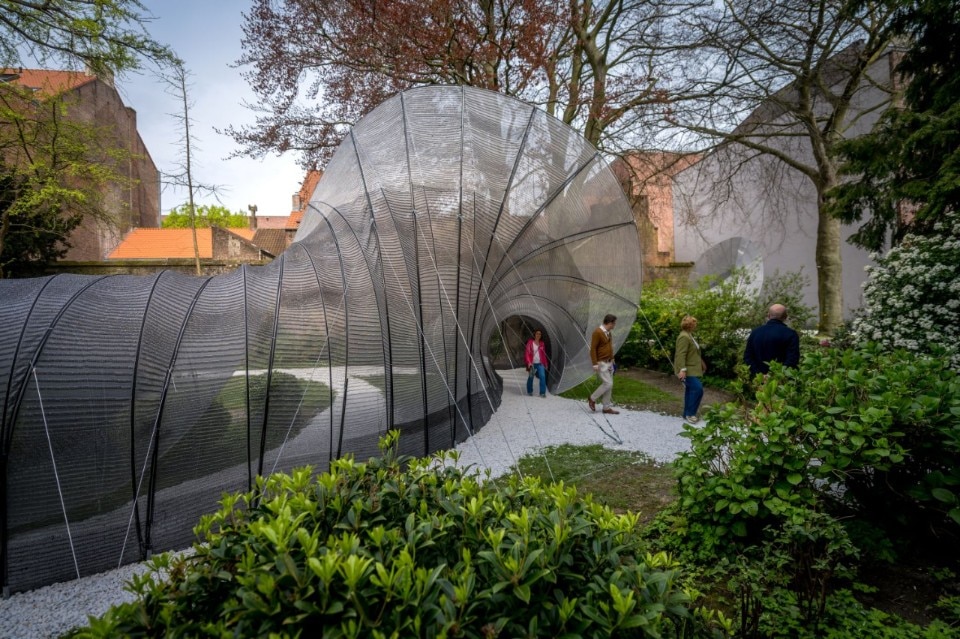A short history of the Bruges Triennial, an event that started in 1968 and developed a hybrid and site-specific approach over time.
The Bruges Triennial transforms the centre of Bruges and the Zeebrugge beach into platforms for contemporary art and architecture. The theme of the Bruges Triennial 2024 focuses on the future and revolves around a reflection: how to deal with sustainability and change in a UNESCO-protected environment, where preservation is central, and what role contemporary art and architecture can play.
To better understand the curatorial approach of the event - and of recent ones in general - one has to look back to the very first editions, held in 1968, 1971 and 1974. The Bruges Triennial was mainly concerned with contemporary art and developed in a museum context. The aim of these exhibitions was to offer a survey of the visual arts in Belgium, promoting the work of both established and emerging artists.
It was one work in particular that inspired the current nature of the event, that is, to confront the works with public space: in 1971, the artist Roger Raveel made four wooden swans, with an empty rectangle in the middle, which he placed on the banks of canals, at water level. These simple works - which some people mistook for billboards for the Triennale - were designed to frame the surface of the waterways, denouncing their pollution. This work urged the city administration to clean the canals regularly in the following years. In 2015, on the occasion of the first new edition of the Triennale, the Canal Swimmer's Club project by the Japanese architecture firm Atelier Bow Wow, is an indirect homage to this history, stating instead that the canals are now clean and swimmable.

2015 is the year that marks the revival of the event after a long stop that lasted over 40 years. The first modern edition, entitled ‘Bruges as megapolis’ investigated the impact of mass tourism on the city: over 5 million people visit the city every year. The alliance between the languages of architecture and art makes it possible to explore the complex dynamics of the city: urbanisation, lifestyles, community, economy, spaces, sounds, energy... In addition to three large ‘traditional’ exhibitions in museum spaces, the Triennale also offers several site-specific installations in urban spaces, created by as many international authors.

The fourth edition of the Bruges Triennial, entitled ‘Spaces of Possibility’ continues this attitude, transforming hidden or unknown places in the city. Twelve international artists and architecture firms have interpreted them from a new perspective and created open-air installations to make people think about social, economic and ecological challenges, creating new connections - between street and square, between people and animals, residents and passers-by. With a programme that also includes talks, exhibitions and guided tours, and with the collaboration of local museums and cultural institutions, the event aims to renew the image of the small town in Flanders, reconciling its historical heritage with the contemporary needs of a collective public space.

 View gallery
View gallery

Triennale di Bruges 2024
SO-IL, Common Thread
Textiles run like a thread through Bruges' past. During the Middle Ages, merchants traded Flemish cloth of the highest quality here. As a result, economic prosperity grew in the city. From the 16th century onwards, Bruges in turn grew into a centre of the lace industry. With Common Thread, SO–IL knits a new chapter into that history. The architecture firm does so not with wool or lace, but with high-tech yarns. These were manufactured from recycled PET bottles. A three-dimensional weaving machine at Delft University of Technology processed the yarns into a semi-transparent membrane. With that, SO–IL is building a tunnel that winds right through the garden of the Capuchin Monastery, connecting two pieces of the West Bruges district. Several openings frame parts of the property and reveal the garden incrementally.

Triennale di Bruges 2024
Studio Ossidiana, Earthsea Pavilion
When Studio Ossidiana visited Bruges, the duo was inspired by an archaeological site where excavation works uncovered several layers of earth. These layers of earth contain numerous stories about local history. This is why Studio Ossidiana brought these layers of earth to the surface. The architectural firm designed a metre-wide silo constructed from earth, peat, shells and leaves. Each layer is full of plant and flower seeds, fungi, minerals and bacteria. These make Earthsea Pavilion a unique ecosystem. The living building attracts insects, birds and other animals. Just like the weather conditions, they affect the installation. The constantly transforming work invites you to discover all its layers and inhabitants. This is how it ushers nature into the city and creates a meeting place for humans, animals and other life forms.

Triennale di Bruges 2024
Studio Ossidiana, Earthsea Pavilion
© VisitBruges | Jan Darthet

Triennale di Bruges 2024
Bangkok Project Studio, The tower of balance
Boonserm Premthada fell completely under the spell of the Belfry. During his visit, a deafening carillon concert began to play just as he was standing right under the immense bells. The artist became fascinated by the sound vibrations. Although the Belfry also caught his eye for another reason. Along with St Saviour's Cathedral and the Church of Our Lady, the brick tower dominates the Bruges skyline. These three ancient monuments symbolise the church and the state. Boonserm Premthada wanted to offer a contemporary, popular counterpoint to that. He is doing so with his open, wooden tower. From three platforms, visitors overlook the West Bruges district, the centre and St Michael's district. At the very top, they ring a bronze bell. In doing so, The tower of balance captures the typical sound of Bruges.

Triennale di Bruges 2024
Bangkok Project Studio, The tower of balance
© VisitBruges | Jan Darthet

Triennale di Bruges 2024
Shingo Masuda + Katsuhisa Otsubo Architects, empty drop
Shingo Masuda and Katsuhisa Otsubo looked at Western Bruges through an Eastern lens. What struck them? That the brick buildings in the compact city centre are close together. And that just about every place there has a function. Shingo Masuda and Katsuhisa Otsubo wanted to break through that pattern. With empty drop, a geometric brick structure, they are celebrating the emptiness in densely built-up Bruges. They are creating a new, open meeting place. These were inspired by Akakura Shrine, a metres-high rock surrounded by a cedar forest. Many Japanese people perform nature rituals there and seek connection. empty drop also connects you to Mother Earth: the work stands among the fruit trees and is actually an ingenious natural product ... as the approximately 11,000 bricks that make up empty drop were made from fired clay.

Triennale di Bruges 2024
Traumnovelle, The Joyful Apocalypse
What belongs to the past and what to the present? Who is a visitor, who is an actor and who is a casual passer-by? The Joyful Apocalypse offers no answers to those questions. On the contrary ... the installation in fact evokes them. The nine-metre-high scaffolding structure charms the courtyard of the City Halls. From its three floors, visitors peer up and down. They observe other walkers ... and at the same time are part of the work. They appear here and there on the reflective aluminium panels. These also reflect the walls of the mediaeval City Halls and the Belfry, which were recognised by UNESCO as a World Heritage Site. Occasionally, a concert or performance takes place in the courtyard. Sometimes planned, maybe also spontaneously.

Triennale di Bruges 2024
Traumnovelle, The Joyful Apocalypse
© VisitBruges | Jan Darthet

Triennale di Bruges 2024
Mariana Castillo Deball, Firesong for the bees, a tree of clay
Some objects go through a real evolution. Their designs are becoming more and more efficient, but as a result, a great deal of diversity sometimes disappears. This is illustrated by Mariana Castillo Deball with her platform Firesong for the bees, a tree of clay. Along the two-and-a-half-metre-high pillars, she stacked dozens of unique ceramic beehives. These refer to historical bee-keeping in Europe. For four thousand years, bee-keepers manufactured their hives from straw, clay and fired ceramics. Because they decorated each of their hives, they looked different everywhere. Until a standard type of hive made its appearance in the 19th century. Three typical simplex hives also play a role here. Atop the installation, they house the bee colony of young Bruges bee-keepers Margot and Uther.

Triennale di Bruges 2024
Mariana Castillo Deball, Firesong for the bees, a tree of clay
© VisitBruges | Jan Darthet

Triennale di Bruges 2024
Mona Hatoum, Full Swing
Prisons and other penitentiary buildings intrigue Mona Hatoum immensely. Because their architecture focuses primarily on control and discipline. She wonders what impact that has on the people who live there. And whether they can thrive in such an oppressive system. With Full Swing, she puts you in their position. Through an uneven staircase, you reach a dark underground room. You walk over and past some aloof gabions filled with rough stones. These evoke feelings of instability, displacement and even fear. Although Mona Hatoum does provide for an engaging balance. In the middle of the underground corridor dangles a swing. With that, you sway towards sunlight and your own freedom. Thus, the swing does add a touch of joy and movement to this alienating place.

Triennale di Bruges 2024
Iván Argote, Who?
Statues take you through history. They tell a story about the city in which you find them. As a result, they bear an important responsibility. What figures do we entrust that task to? Iván Argote wonders aloud about this. He installed a weathered pair of bronze boots on the Speelmansrei. Whose are they? As a visitor, you fill in those blanks yourself. In doing so, Iván Argote is feeding a current debate. Countless statues of mostly white, influential men stand around the world. In Colombia too – the artist's homeland – many monuments refer to white colonisers and rulers ... and not to local residents. This is what Iván Argote makes you think about. Who? is the first work in a bold series of statues.

Triennale di Bruges 2024
Norell/Rodhe, Raamland
How do you deal with discarded materials and forgotten places in the city? Norell/Rodhe answers those two questions with Raamland. The architectural duo transformed an anonymous square into an inspirational resting and meeting place with a pavilion. How did Norell/Rodhe do that? Almost entirely with second-hand materials. You'll spot an old bathtub, a stocked bookcase and even some items from a former nightclub. These unique finds and everyday items give the square a new, surprising function. Along with native herbs and shrubs, they form an abstract interior that feels both homely and ramshackle. Although the setting does especially invite you to hang out here, read a book or maybe put your hands to work.

Triennale di Bruges 2024
Sumayya Vally, Grains of Paradise
Bruges' rich trading past? We pretty much always look at that through a European lens. Sumayya Vally takes a different approach. She examined 14th and 15th-century trading relations between prosperous Bruges and the African continent. And she examined the impact that this collaboration had on Africa. With Grains of Paradise, she invites you to do the same. She installed a series of blackened pirogues on the Lake of Love. These refer to the floating markets in certain parts of Africa, such as on the Congo River. Sumayya Vally filled the pirogues with plants and spices, including the malagueta pepper. This flavourful, beneficial pepper originated in the Gulf of Guinea and was very popular with the mediaeval people of Bruges. This is why the pepper was nicknamed the 'grain of paradise' in our region.

Triennale di Bruges 2024
Adrien Tirtiaux, Under the Carpet
During the 1930s, St John's Hospital was struggling with a lack of space. Therefore, it was joined by the Minnewater Hospital. In order to quickly transport patients from one hospital to another, Prof. Dr. Joseph Sebrechts proposed building a connecting road. This road was built in 1938, but fell into complete disrepair after 1976. Yet the route never completely disappeared. As a contemporary archaeologist, Adrien Tirtiaux uncovered part of the road again. He takes you in tow along its most impressive stretches. For example, he takes you to a striking viaduct and shows you the entrance to an underground tunnel. There, he rolled out some thick, frivolous 'moss carpets'. He also uses an ingenious mirror to revive the forgotten, swept under the rug connecting road.

Triennale di Bruges 2024
Ivan Morison, Star of the Sea
Our unpredictable world is constantly changing. This is why Ivan Morison subjects his installation to wind, water and sand. He lets Star of the Sea rest on the beach. There, the merciless elements will test how impermanent art may or may not be. Once you enter the concrete sewer pipes, you will become part of this pure environment yourself. You will complete a star-shaped course. Along the way, various openings will each cast a different view outside. Sometimes, they frame the dunes or the sea. Further on, they take aim at the international port or the villas on the seafront. The architecture of Star of the Sea also refers to the versatility along the Belgian coast. The work is halfway between a bunker, a fort and a sandcastle on the beach.

Triennale di Bruges 2024
SO-IL, Common Thread
Textiles run like a thread through Bruges' past. During the Middle Ages, merchants traded Flemish cloth of the highest quality here. As a result, economic prosperity grew in the city. From the 16th century onwards, Bruges in turn grew into a centre of the lace industry. With Common Thread, SO–IL knits a new chapter into that history. The architecture firm does so not with wool or lace, but with high-tech yarns. These were manufactured from recycled PET bottles. A three-dimensional weaving machine at Delft University of Technology processed the yarns into a semi-transparent membrane. With that, SO–IL is building a tunnel that winds right through the garden of the Capuchin Monastery, connecting two pieces of the West Bruges district. Several openings frame parts of the property and reveal the garden incrementally.

Triennale di Bruges 2024
Studio Ossidiana, Earthsea Pavilion
When Studio Ossidiana visited Bruges, the duo was inspired by an archaeological site where excavation works uncovered several layers of earth. These layers of earth contain numerous stories about local history. This is why Studio Ossidiana brought these layers of earth to the surface. The architectural firm designed a metre-wide silo constructed from earth, peat, shells and leaves. Each layer is full of plant and flower seeds, fungi, minerals and bacteria. These make Earthsea Pavilion a unique ecosystem. The living building attracts insects, birds and other animals. Just like the weather conditions, they affect the installation. The constantly transforming work invites you to discover all its layers and inhabitants. This is how it ushers nature into the city and creates a meeting place for humans, animals and other life forms.

Triennale di Bruges 2024
Studio Ossidiana, Earthsea Pavilion
© VisitBruges | Jan Darthet

Triennale di Bruges 2024
Bangkok Project Studio, The tower of balance
Boonserm Premthada fell completely under the spell of the Belfry. During his visit, a deafening carillon concert began to play just as he was standing right under the immense bells. The artist became fascinated by the sound vibrations. Although the Belfry also caught his eye for another reason. Along with St Saviour's Cathedral and the Church of Our Lady, the brick tower dominates the Bruges skyline. These three ancient monuments symbolise the church and the state. Boonserm Premthada wanted to offer a contemporary, popular counterpoint to that. He is doing so with his open, wooden tower. From three platforms, visitors overlook the West Bruges district, the centre and St Michael's district. At the very top, they ring a bronze bell. In doing so, The tower of balance captures the typical sound of Bruges.

Triennale di Bruges 2024
Bangkok Project Studio, The tower of balance
© VisitBruges | Jan Darthet

Triennale di Bruges 2024
Shingo Masuda + Katsuhisa Otsubo Architects, empty drop
Shingo Masuda and Katsuhisa Otsubo looked at Western Bruges through an Eastern lens. What struck them? That the brick buildings in the compact city centre are close together. And that just about every place there has a function. Shingo Masuda and Katsuhisa Otsubo wanted to break through that pattern. With empty drop, a geometric brick structure, they are celebrating the emptiness in densely built-up Bruges. They are creating a new, open meeting place. These were inspired by Akakura Shrine, a metres-high rock surrounded by a cedar forest. Many Japanese people perform nature rituals there and seek connection. empty drop also connects you to Mother Earth: the work stands among the fruit trees and is actually an ingenious natural product ... as the approximately 11,000 bricks that make up empty drop were made from fired clay.

Triennale di Bruges 2024
Traumnovelle, The Joyful Apocalypse
What belongs to the past and what to the present? Who is a visitor, who is an actor and who is a casual passer-by? The Joyful Apocalypse offers no answers to those questions. On the contrary ... the installation in fact evokes them. The nine-metre-high scaffolding structure charms the courtyard of the City Halls. From its three floors, visitors peer up and down. They observe other walkers ... and at the same time are part of the work. They appear here and there on the reflective aluminium panels. These also reflect the walls of the mediaeval City Halls and the Belfry, which were recognised by UNESCO as a World Heritage Site. Occasionally, a concert or performance takes place in the courtyard. Sometimes planned, maybe also spontaneously.

Triennale di Bruges 2024
Traumnovelle, The Joyful Apocalypse
© VisitBruges | Jan Darthet

Triennale di Bruges 2024
Mariana Castillo Deball, Firesong for the bees, a tree of clay
Some objects go through a real evolution. Their designs are becoming more and more efficient, but as a result, a great deal of diversity sometimes disappears. This is illustrated by Mariana Castillo Deball with her platform Firesong for the bees, a tree of clay. Along the two-and-a-half-metre-high pillars, she stacked dozens of unique ceramic beehives. These refer to historical bee-keeping in Europe. For four thousand years, bee-keepers manufactured their hives from straw, clay and fired ceramics. Because they decorated each of their hives, they looked different everywhere. Until a standard type of hive made its appearance in the 19th century. Three typical simplex hives also play a role here. Atop the installation, they house the bee colony of young Bruges bee-keepers Margot and Uther.

Triennale di Bruges 2024
Mariana Castillo Deball, Firesong for the bees, a tree of clay
© VisitBruges | Jan Darthet

Triennale di Bruges 2024
Mona Hatoum, Full Swing
Prisons and other penitentiary buildings intrigue Mona Hatoum immensely. Because their architecture focuses primarily on control and discipline. She wonders what impact that has on the people who live there. And whether they can thrive in such an oppressive system. With Full Swing, she puts you in their position. Through an uneven staircase, you reach a dark underground room. You walk over and past some aloof gabions filled with rough stones. These evoke feelings of instability, displacement and even fear. Although Mona Hatoum does provide for an engaging balance. In the middle of the underground corridor dangles a swing. With that, you sway towards sunlight and your own freedom. Thus, the swing does add a touch of joy and movement to this alienating place.

Triennale di Bruges 2024
Iván Argote, Who?
Statues take you through history. They tell a story about the city in which you find them. As a result, they bear an important responsibility. What figures do we entrust that task to? Iván Argote wonders aloud about this. He installed a weathered pair of bronze boots on the Speelmansrei. Whose are they? As a visitor, you fill in those blanks yourself. In doing so, Iván Argote is feeding a current debate. Countless statues of mostly white, influential men stand around the world. In Colombia too – the artist's homeland – many monuments refer to white colonisers and rulers ... and not to local residents. This is what Iván Argote makes you think about. Who? is the first work in a bold series of statues.

Triennale di Bruges 2024
Norell/Rodhe, Raamland
How do you deal with discarded materials and forgotten places in the city? Norell/Rodhe answers those two questions with Raamland. The architectural duo transformed an anonymous square into an inspirational resting and meeting place with a pavilion. How did Norell/Rodhe do that? Almost entirely with second-hand materials. You'll spot an old bathtub, a stocked bookcase and even some items from a former nightclub. These unique finds and everyday items give the square a new, surprising function. Along with native herbs and shrubs, they form an abstract interior that feels both homely and ramshackle. Although the setting does especially invite you to hang out here, read a book or maybe put your hands to work.

Triennale di Bruges 2024
Sumayya Vally, Grains of Paradise
Bruges' rich trading past? We pretty much always look at that through a European lens. Sumayya Vally takes a different approach. She examined 14th and 15th-century trading relations between prosperous Bruges and the African continent. And she examined the impact that this collaboration had on Africa. With Grains of Paradise, she invites you to do the same. She installed a series of blackened pirogues on the Lake of Love. These refer to the floating markets in certain parts of Africa, such as on the Congo River. Sumayya Vally filled the pirogues with plants and spices, including the malagueta pepper. This flavourful, beneficial pepper originated in the Gulf of Guinea and was very popular with the mediaeval people of Bruges. This is why the pepper was nicknamed the 'grain of paradise' in our region.

Triennale di Bruges 2024
Adrien Tirtiaux, Under the Carpet
During the 1930s, St John's Hospital was struggling with a lack of space. Therefore, it was joined by the Minnewater Hospital. In order to quickly transport patients from one hospital to another, Prof. Dr. Joseph Sebrechts proposed building a connecting road. This road was built in 1938, but fell into complete disrepair after 1976. Yet the route never completely disappeared. As a contemporary archaeologist, Adrien Tirtiaux uncovered part of the road again. He takes you in tow along its most impressive stretches. For example, he takes you to a striking viaduct and shows you the entrance to an underground tunnel. There, he rolled out some thick, frivolous 'moss carpets'. He also uses an ingenious mirror to revive the forgotten, swept under the rug connecting road.

Triennale di Bruges 2024
Ivan Morison, Star of the Sea
Our unpredictable world is constantly changing. This is why Ivan Morison subjects his installation to wind, water and sand. He lets Star of the Sea rest on the beach. There, the merciless elements will test how impermanent art may or may not be. Once you enter the concrete sewer pipes, you will become part of this pure environment yourself. You will complete a star-shaped course. Along the way, various openings will each cast a different view outside. Sometimes, they frame the dunes or the sea. Further on, they take aim at the international port or the villas on the seafront. The architecture of Star of the Sea also refers to the versatility along the Belgian coast. The work is halfway between a bunker, a fort and a sandcastle on the beach.
- Event:
- Triennale Brugge
- Topic:
- Spaces of Possibility
- Curated by:
- Shendy Gardin and Sevie Tsampalla
- Opening dates:
- until 1 September 2024
- Visit Bruges website:
- www.visitbruges.be/triennale
- Visit Flanders website:
- www.visitflanders.com






